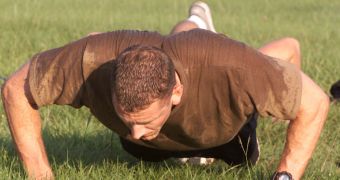This pathetic creature has reached the status of the most efficient killer on the planet.
What turned the weaponless ape named human into what we are today? "Hairless, clawless, and largely weaponless, ancient humans used the unlikely combination of sweatiness and relentlessness to gain the upper hand over their faster, stronger, generally more dangerous animal prey," said Harvard Anthropology Professor Daniel Lieberman.
His theories about the importance of running on early humans explain why we're the only species that voluntarily runs extremely large distances, like the 26.2 miles (42 km) of a marathon.
In fact, nature's best runners, like the gazelles, antelopes and cheetahs, are built for speed, not endurance: after a race of 800 m a cheetah is completely exhausted and needs many minutes to recover. "Even nature's best animal distance runners - such as horses and dogs - will run similar distances only if forced to do so, and the startling evidence is that humans are better at it. Animals are terrible athletes in terms of power and speed, but we're phenomenal at slow and steady. We're the tortoises of the animal kingdom," Lieberman said.
This contradicts the theory that our physical impotence forced us to develop our big brains and advanced weapons, and that till then we were vegetarians at the disposal of fiercer predators. "The problem with that theory is that we began adding meat to our diets around 2.6 million years ago, long before we developed advanced weapons like the bow and arrow, which was developed as recently as 50,000 years ago. The appearance about 2 million years ago of physical adaptations that have no impact on walking but that make humans better endurance runners provide evidence that early scavengers became running hunters", said Lieberman.
Indeed, compared to other apes, humans have long, springy tendons in their legs and feet that function like large elastics, that store energy and release it with each running stride, decreasing the energy amount wasted with each step.
We have several adaptations for running, such as the arm counterbalancing, developed butt muscles that maintain bodies upright, an elastic ligament in our neck to keep our head steady and a thinner and very flexible waist compared to the ape's that allows us to counterbalance the upper body. "Once humans start running, it only takes a bit more energy for us to run faster," Lieberman said.
Most animals, instead, spend much more energy to speed up, particularly from a trot to a gallop, which cannot be maintained for long distances.
Moreover, Lieberman believes that our secret evolutionary weapon is the ability to run in the heat. This may explain our hairlessness. "Humans have several adaptations that help us dump the enormous amounts of heat generated by running. These adaptations include our hairlessness, our ability to sweat, and the fact that we breathe through our mouths when we run, which not only allows us to take bigger breaths, but also helps dump heat. We can run in conditions that no other animal can run in. While animals get rid of excess heat by panting, they can't pant when they gallop," Lieberman said.
This ability of the ancient humans outran their lack of speed over short or long distances: they just had to run for longer periods of time. "All together, these adaptations allowed us to relentlessly pursue game in the hottest part of the day when most animals rest. Humans likely practiced persistence hunting, chasing a game animal during the heat of the day, making it run faster than it could maintain, tracking and flushing it if it tried to rest, and repeating the process until the animal literally overheated and collapsed." said Lieberman.
"Most animals would develop hyperthermia - heat stroke in humans - after about 10 to 15 kilometers. By the end of the process, even humans with their crude early weapons could have overcome stronger and more dangerous prey. Adding credence to the theory is the fact that some aboriginal humans still practice persistence hunting today, and it remains an effective technique. It requires very minimal technology, has a high success rate, and yields a lot of meat." said Lieberman.
In fact, this type of hunt is still practiced today by the San people (Bushmen), which are in the Paleolithic stage of development (well, till the contact with Bantu and Europeans).
Not surprisingly, they are considered the oldest living human race.
Lieberman said the first humans were scavengers, but in time, evolution selected the humans who could run faster to the site where a corpse lay and the increasing performance turned the early people into persistence hunters. Faster runners were selected till projectile weapons enabled early people to kill without the long run. "Endurance running is part of a suite of shifts that made Homo [the genus that includes modern people] human," Lieberman said.

 14 DAY TRIAL //
14 DAY TRIAL //